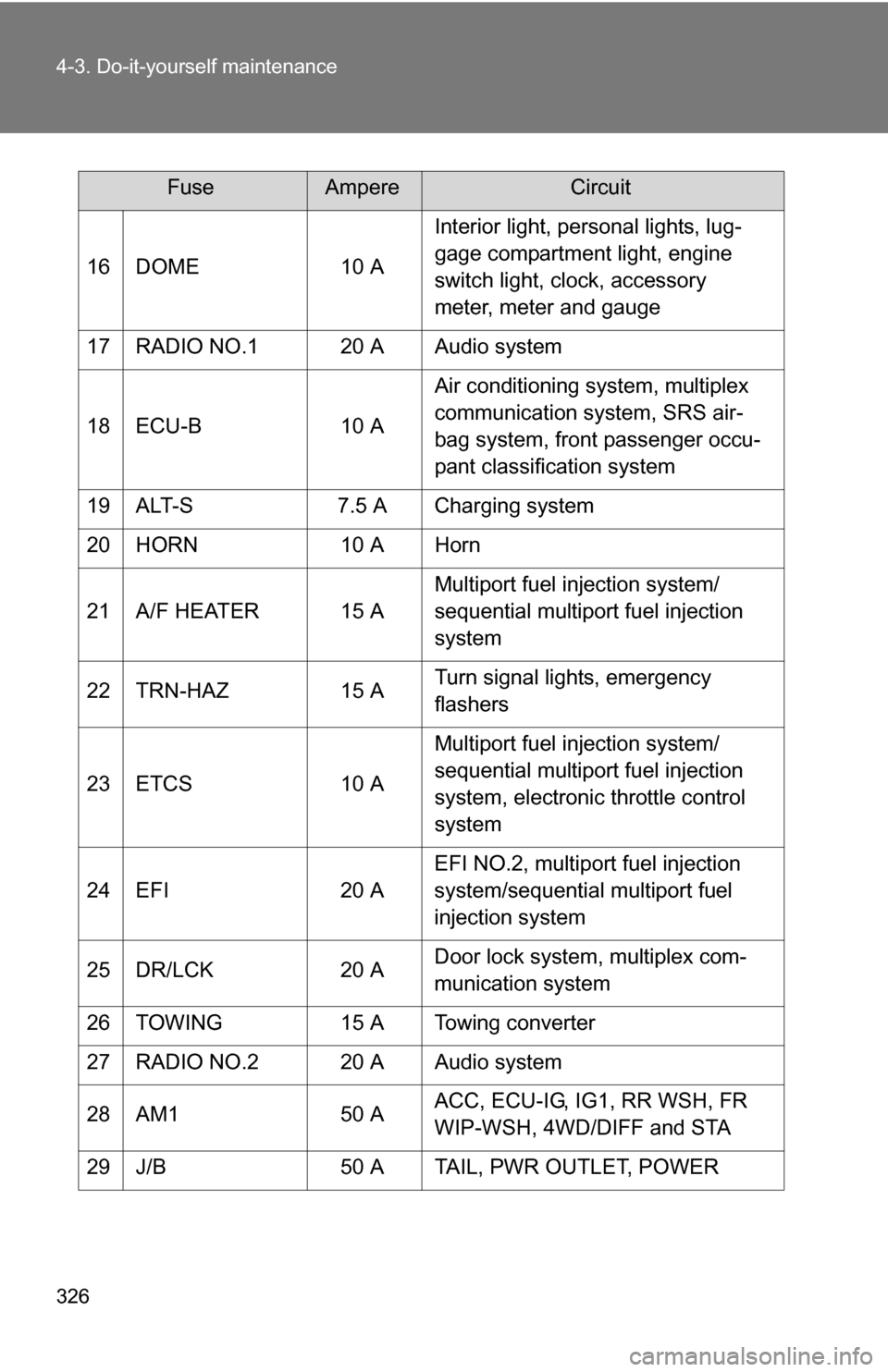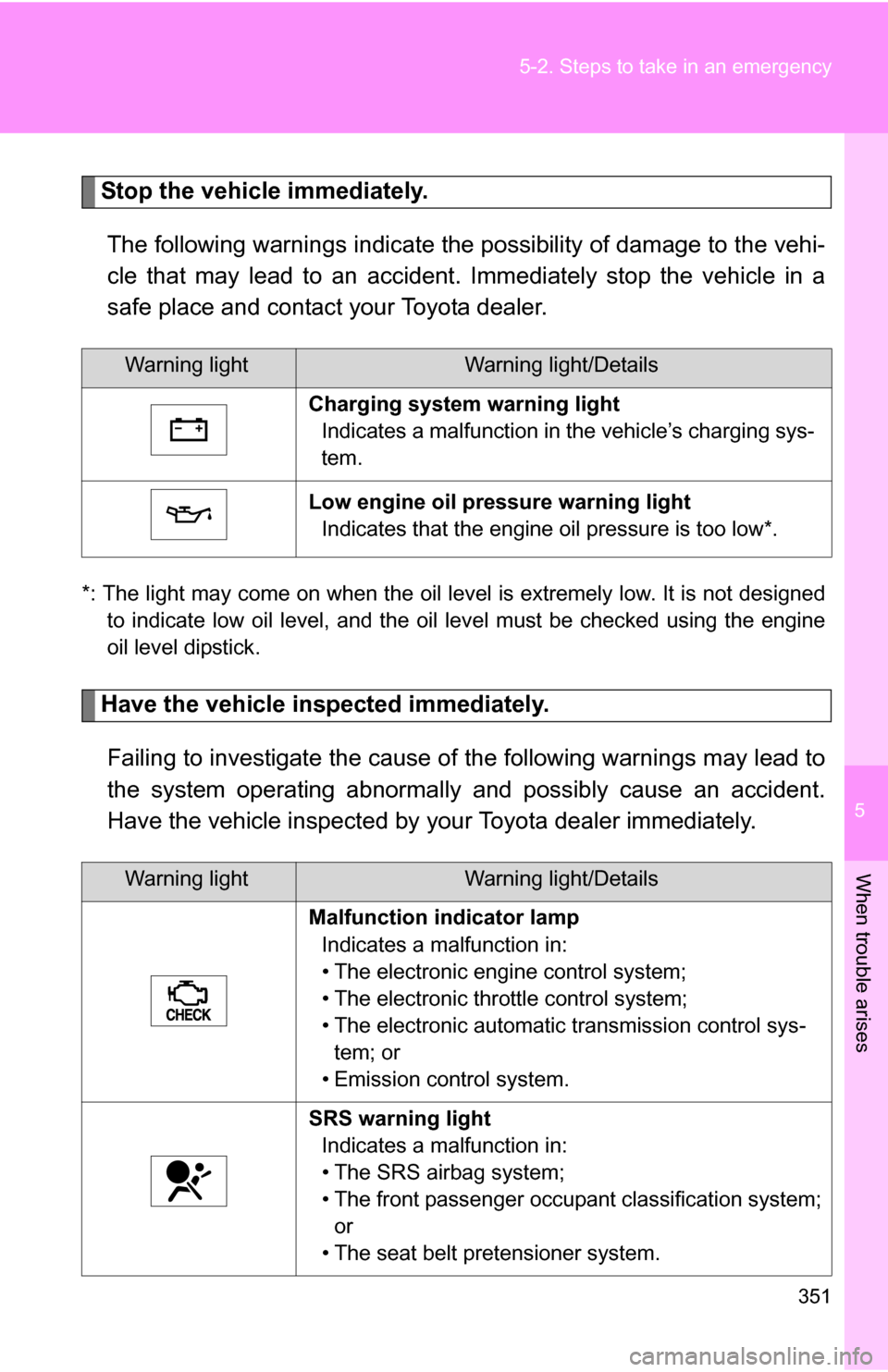2009 TOYOTA FJ CRUISER charging
[x] Cancel search: chargingPage 70 of 432

70 1-5. Refueling
CAUTION
■Refueling the vehicle
Observe the following precautions while refueling the vehicle.
Failure to do so, may result in death or serious injury.
●Touch the vehicle or some other metal surface to discharge any static
electricity.
Sparks resulting from discharging static electricity may cause the fuel
vapors to ignite.
● Always hold the grips on the fuel tank cap and turn it slowly to remove it.
A whooshing sound may be heard when the fuel tank cap is loosened.
Wait until the sound cannot be heard before fully removing the cap.
In hot weather, pressurized fuel may spray out of the filler neck and cause
injury.
● Do not allow anyone that has not discharged static electricity from their
bodies to come close to an open fuel tank.
● Do not inhale vaporized fuel.
Fuel contains substances that are harmful if inhaled.
● Do not smoke while refueling the vehicle.
Doing so may cause the fuel to ignite and cause a fire.
● Do not return to the vehicle or touch any person or object that is statically
charged.
This may cause static electricity to build up, resulting in a possible engine
hazard.
■ When replacing the fuel tank cap
Do not use anything but a genuine Toyota fuel tank cap designed for your
vehicle. Doing so may cause a fire or other incident which may result in
death or serious injury.
Page 300 of 432

300 4-3. Do-it-yourself maintenance
■Checking battery condition
Check the battery condition using the indicator color.
Blue: Good condition
White: Charging is necessary.
Have the vehicle inspected by
your Toyota dealer.
Red: Not working properly,
have the battery checked by
your Toyota dealer.
■Before recharging
When recharging, the battery produces hydrogen gas which is flammable
and explosive. Therefore, before recharging:
●If recharging with the battery installed on the vehicle, be sure to discon-
nect the ground cable.
● Make sure the power switch on the charger is off when connecting and
disconnecting the charger cables to the battery.
CAUTION
■Chemicals in the battery
A battery contains poisonous and corrosive sulfuric acid and may produce
hydrogen gas which is flammable and explosive. To reduce the risk of death
or serious injury, take the following precautions while working on or near bat-
tery:
● Do not cause sparks by touching the battery terminals with tools.
● Do not smoke or light a match near the battery.
● Avoid contact with eyes, skin and clothes.
● Never inhale or swallow electrolyte.
● Wear protective safety glasses when working near the battery.
● Keep children away from the battery.
Page 301 of 432

301
4-3. Do-it-yourself maintenance
4
Maintenance and care
CAUTION
■
Where to safety charge the battery
Always charge the battery in an open area. Do not charge the battery in a
garage or closed room where there is not sufficient ventilation.
■ How to recharge the battery
Only perform a slow charge (5A or less).
The battery may explode if charged at a quicker rate.
■ Emergency measures regarding electrolyte
●If electrolyte gets in your eyes
Flush your eyes with clean water for at least 15 minutes and get immedi-
ate medical attention. If possible, continue to apply water with a sponge or
cloth while traveling to the nearest medical facility.
● If electrolyte gets on your skin
Wash the affected area thoroughly. If you feel pain or burning, get medical
attention immediately.
● If electrolyte gets on your clothes
It can soak through clothing on to your skin. Immediately take off the cloth-
ing and follow the procedure above if necessary.
● If you accidentally swallow electrolyte
Drink a large quantity of water or milk. Follow with milk of magnesia,
beaten raw egg or vegetable oil. Get emergency medical attention immedi-
ately.
NOTICE
■When recharging the battery
Never recharge the battery while the engine is running. Also, be sure all
accessories are turned off.
Page 326 of 432

326 4-3. Do-it-yourself maintenance
16 DOME10 AInterior light, personal lights, lug-
gage compartment light, engine
switch light, clock, accessory
meter, meter and gauge
17 RADIO NO.1 20 A Audio system
18 ECU-B 10 AAir conditioning system, multiplex
communication system, SRS air-
bag system, front passenger occu-
pant classification system
19 ALT-S 7.5 A Charging system
20 HORN 10 A Horn
21 A/F HEATER 15 A Multiport fuel injection system/
sequential multiport fuel injection
system
22 TRN-HAZ 15 ATurn signal lights, emergency
flashers
23 ETCS 10 AMultiport fuel injection system/
sequential multiport fuel injection
system, electronic throttle control
system
24 EFI 20 AEFI NO.2, multiport fuel injection
system/sequential multiport fuel
injection system
25 DR/LCK 20 ADoor lock system, multiplex com-
munication system
26 TOWING 15 A Towing converter
27 RADIO NO.2 20 A Audio system
28 AM1 50 AACC, ECU-IG, IG1, RR WSH, FR
WIP-WSH, 4WD/DIFF and STA
29 J/B 50 A TAIL, PWR OUTLET, POWER
FuseAmpereCircuit
Page 329 of 432

329
4-3. Do-it-yourself maintenance
4
Maintenance and care
7 ECU-IG
10 AAnti-lock brake system, vehicle sta-
bility control system, traction con-
trol system, active traction control
system, AUTO LSD system, multi-
port fuel injection system/sequen-
tial multiport fuel injection system,
cruise control system, back door
lock system, shift lock system, mul-
tiplex communication system
8 IG1 15 ATurn signal lights, air conditioning
system, charging system, clutch
start cancel switch, anti-lock brake
system, traction control system,
active traction control system, vehi-
cle stability control system, AUTO
LSD system, back-up lights, intui-
tive parking assist, rear differential
lock system, power outlet, acces-
sory meter, meter and gauge, rear
view monitor system
9 STA 7.5 AStarting system, clutch start cancel
switch, power outlet
10 TAIL 10 ATail lights, license plate lights, park-
ing lights, instrument panel light
control, illuminations
11 A C C 7 . 5 AShift lock system, outside rear view
mirrors, audio system, power out-
let, clock, accessory meter, multi-
plex communication system
12 POWER 30 A Power windows
FuseAmpereCircuit
Page 351 of 432

5
When trouble arises
351
5-2. Steps to take in an emergency
Stop the vehicle immediately.
The following warnings indicate the possibility of damage to the vehi-
cle that may lead to an accident. Immediately stop the vehicle in a
safe place and contact your Toyota dealer.
*: The light may come on when the oil level is extremely low. It is not designed to indicate low oil level, and the oil level must be checked using the engine
oil level dipstick.
Have the vehicle inspected immediately.
Failing to investigate the cause of the following warnings may lead to
the system operating abnormally and possibly cause an accident.
Have the vehicle inspected by your Toyota dealer immediately.
Warning lightWarning light/Details
Charging system warning light Indicates a malfunction in the vehicle’s charging sys-
tem.
Low engine oil pressure warning light Indicates that the engine oil pressure is too low*.
Warning lightWarning light/Details
Malfunction indicator lamp Indicates a malfunction in:
• The electronic engine control system;
• The electronic throttle control system;
• The electronic automatic transmission control sys-tem; or
• Emission control system.
SRS warning light Indicates a malfunction in:
• The SRS airbag system;
• The front passenger occupant classification system; or
• The seat belt pretensioner system.
Page 388 of 432

388 6-1. Specifications
Cooling system
Ignition system
Electrical system
CapacityVehicles with an automatic transmission
10.4 qt. (9.8 L, 8.6 Imp.qt.)
Vehicles with a manual transmission
9.9 qt. (9.4 L, 8.3 Imp. qt.)
Coolant typeUse either of the following.
• “Toyota Super Long Life Coolant”
• Similar high-quality ethylene glycol-based non-silicate, non-amine, non-nitrite, and
non-borate coolant with long-life hybrid
organic acid technology
Do not use plain water alone.
Spark plug
Make DENSO NGK K20HR-U11
LFR6C11
Gap
0.043 in. (1.1 mm)
Battery
Open voltage at
68F (20 C): 12.6 12.8 V Fully charged
12.2 12.4 V Half charged
11 . 8
12.0 V Discharged
(Voltage checked 20 minutes after
the key is removed with all the lights
turned off)
Charging rates 5 A max.
Page 418 of 432

418
Alphabetical index
Alphabetical index
A/C ............................................. 198
ABS ........................................... 168
Access doors .............................36
Accessory meter ...................... 137
Active traction control system .................................... 160
Air conditioning filter............... 315
Air conditioning system
Air conditioning filter .............. 315
Manual air conditioning system ................................ 198
Airbags Airbag operating conditions.....80
Airbag precautions for your
child ......................................85
Airbag warning light............... 351
Curtain shield airbag operating
conditions..............................80
Curtain shield airbag
precautions ...........................87
Front passenger occupant classification system .............90
General airbag precautions .....84
Locations of airbags ................77
Modification and disposal of airbags ..................................88
Proper driving posture .......75, 84
Side airbag operating conditions..............................80
Side airbag precautions ..........86
SRS airbags ............................77
Antenna..................................... 213
Anti-lock brake system ABS warning light .................. 351
Anti-lock brake system .......... 168
Armrest ..................................... 261
Audio input ............................... 236
Audio remote controls............. 238
Audio system Antenna ................................. 213
Audio input ............................ 236
AUX adapter.......................... 236
CD player .............................. 214 MP3/WMA disc ..................... 222
Optimal use ........................... 231
Portable music player ........... 236
Radio..................................... 208
Steering wheel audio
switch.................................. 238
Sub woofer ............................ 234
Type ...................................... 205
AUTO LSD system ................... 162
Automatic light off system...... 140
Automatic limited slip differential .............................. 162
Automatic transmission
Automatic transmission ......... 123
If the shift lever cannot be shifted from P ..................... 373
AUX adapter ............................. 236
Auxiliary box .................... 243, 249
Back door ................................... 38
Back door lock ........................... 38
Back-up lights Replacing light bulbs ............. 335
Wattage................................. 393
Back window .............................. 41
Battery Charging system warning
light ..................................... 351
Checking ............................... 299
If the vehicle battery is discharged .......................... 375
Preparing and checking before winter ....................... 182
Bottle holders................... 243, 248
Brake assist.............................. 168
Brakes Brake system warning
buzzer ................. 161, 163, 171
Brake system warning light ... 350
Fluid ...................................... 296
Parking brake ........................ 128
Break-in tips ............................. 112A
B